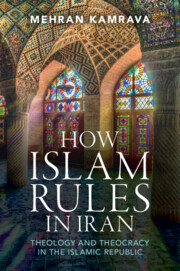Book contents
- How Islam Rules in Iran
- How Islam Rules in Iran
- Copyright page
- Contents
- Preface
- 1 Introduction
- 2 The Setting
- 3 A Question of Jurisprudence
- 4 Social Protection and Guidance
- 5 Rethinking the Islamic Republic
- 6 Theorizing Islamic Democracy
- 7 Legitimate Authority
- 8 Khameneism and the Absolute Velayat-e Faqih
- 9 Whither the Islamic Republic?
- Appendix Brief Biography of Some of the Figures Discussed
- Glossary
- Bibliography
- Index
6 - Theorizing Islamic Democracy
Published online by Cambridge University Press: 02 May 2024
- How Islam Rules in Iran
- How Islam Rules in Iran
- Copyright page
- Contents
- Preface
- 1 Introduction
- 2 The Setting
- 3 A Question of Jurisprudence
- 4 Social Protection and Guidance
- 5 Rethinking the Islamic Republic
- 6 Theorizing Islamic Democracy
- 7 Legitimate Authority
- 8 Khameneism and the Absolute Velayat-e Faqih
- 9 Whither the Islamic Republic?
- Appendix Brief Biography of Some of the Figures Discussed
- Glossary
- Bibliography
- Index
Summary
This chapter focuses on the arguments of precisely the kind of individual described by Kadivar. More specifically, within the intellectual reformist current described in the previous chapter, the arguments of a number of particular figures associated with it deserve more in-depth treatment. These individuals took the hermeneutics movement started by Soroush one step further by theorizing about Islamic democracy. They made explicit one of the key dimensions that is implicit in the hermeneutics movement, namely that, interpreted correctly, there is deep theoretical and structural consistency between Islam and democracy. As with their intellectual predecessors, this new crop of scholars start with the assumption that religious teachings are powerfully influenced by social conditions. Many religious rules came about to address specific social conditions that existed at a particular time and place, they argue, and therefore may not apply at other times. By the same token, understanding the teachings of religion and acquiring religious knowledge also depend on prevailing conditions.
Keywords
- Type
- Chapter
- Information
- How Islam Rules in IranTheology and Theocracy in the Islamic Republic, pp. 202 - 237Publisher: Cambridge University PressPrint publication year: 2024



